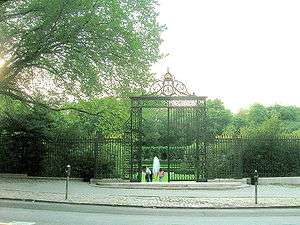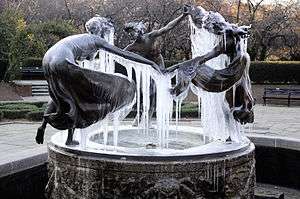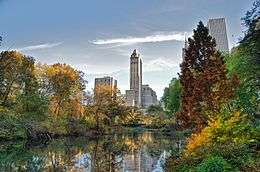Conservatory Garden
Conservatory Garden is a formal garden in the northeastern corner of Central Park near Museum Mile, Manhattan, New York City. It is located between 104th and 106th Streets west of Fifth Avenue. Comprising 6 acres (24,000 m2), it is the only formal garden in Central Park. Conservatory Garden takes its name from a conservatory that stood on the site from 1898 to 1935.

History
The park's head gardener, Ignatz Anton Pilát, originally stored plants at the site of Conservatory Garden during the construction of Central Park.[1]:55–56 At the time, park architects Frederick Law Olmsted and Calvert Vaux wanted to landscape most of the northeast corner of Central Park as part of an arboretum, including the site of the current Conservatory Garden and Harlem Meer. However, this proposal was not implemented because of a lack of funds.[2]:146 Additionally, a formal conservatory had been planned for Conservatory Water, further south in Central Park, but was never built.[2]:144
A greenhouse on the site of Conservatory Garden was erected in 1898, and it contained exhibitions of plants and flower beds.[2]:146 Later, the glasshouses at the site were used to harden hardwood cuttings for the park's plantings.
In 1935, NYC Parks commissioner Robert Moses destroyed the greenhouse since he believed it was obsolete.[3] After the conservatory was torn down, the garden was designed by Gilmore D. Clarke, landscape architect for Moses, with planting plans by M. Betty Sprout.[4] Constructed and planted by WPA workers, it was opened to the public in 1937.[2]:146
After World War II the garden had become neglected, and by the 1970s a wasteland. It was restored and partially replanted under the direction of horticulturist and urban landscape designer Lynden Miller[5][6] and reopened in June 1987.[1]:144–145[7] The overgrown, top-heavy crabapples were freed of watershoots and pruned up to a higher scaffold for better form. The high-style mixed planting was the first to bring estate garden style to urban parks, part of the general renewal of Central Park under Elizabeth Barlow Rogers of the Central Park Conservancy.[7]
Sections
The Garden is composed of three distinct parts, skillfully restored since the 1980s.[2]:146 It is accessible through the Vanderbilt Gate at Fifth Avenue and 105th Street, a quarter mile (400 m) south of the park's northeast corner. The Vanderbilt Gate once gave access to the forecourt of Cornelius Vanderbilt II's chateau designed by George Browne Post, the grandest of the Fifth Avenue mansions of the Gilded Age, at 58th Street and Fifth Avenue, sharing the Plaza with the Plaza Hotel. The wrought iron gates with cast iron and repoussé details, were designed by Post and executed in an iron foundry in Paris.[8]
Below the steps flanked by Cornelian cherry (Cornus mas), the central section of the Conservatory Garden is a symmetrical lawn outlined in clipped yew,[note 1] with a single central fountain jet at the rear. It is flanked by twin allées of crabapples and backed by a curved wisteria pergola against the steep natural slope, that is dominated at its skyline by a giant American Sycamore. Otherwise there is no flower color: instead, on any fine Saturday afternoon in June, it is the scene of photography sessions for colorful wedding parties, for which limousines pull up in rows on Fifth Avenue.[9]
To the left on the south side, is the garden of mixed herbaceous borders in wide concentric bands around The Secret Garden water lily pool, dedicated in 1936 to the memory of Frances Hodgson Burnett, with sculpture by Bessie Potter Vonnoh.[8] Some large shrubs, like tree lilac, magnolias, buddleias and Cornus alba 'elegantissima' provide vertical structure and offer light shade to offset the sunny locations, planted by Lynden Miller with a wide range of hardy perennials and decorative grasses, intermixed with annuals planted to seem naturalized. This garden has seasonal features to draw visitors from April through October.

To the right of the central formal plat is a garden also in concentric circles, round the Untermyer Fountain, which was donated by the family of Samuel Untermyer in 1947. The bronze figures, Three Dancing Maidens by Walter Schott (1861–1938), were executed in Germany about 1910 [10] and formed a fountain at Untermyer's estate "Greystone" in Yonkers, New York.
This section of the Conservatory Garden has two dramatic seasons of massed display, of tulips in the spring and Korean chrysanthemums in the fall. Beds of santolina clipped in knotted designs with contrasting bronze-leaved bedding begonias surround the fountain, and four rose arbor gates are planted with reblooming 'Silver Moon' and 'Betty Prior' roses.
Notes
- Designated "French" or "Italian" equally by journalists; in autumn 2006 the yews were replanted with more naturally spreading Taxus media ‘Hatfieldii' cultivars that will make low formal shaping easier to maintain.
References
- Kinkead, Eugene (1990). Central Park, 1857–1995: The Birth, Decline, and Renewal of a National Treasure. New York: Norton. ISBN 0-393-02531-4.
- Miller, Sara (2003). Central Park : an American masterpiece. New York: Harry N. Abrams Publishers in association with the Central Park Conservancy. ISBN 978-0-8109-3946-2. OCLC 50773395.
- "CITY TO DEMOLISH PARK GREENHOUSES; 22 Structures in Central Park Found to Be Deteriorating and Will Be Razed". The New York Times. 1934-11-08. ISSN 0362-4331. Retrieved 2019-04-09.
- M. Betty Sprout, ASLA, (1906–1962), an accomplished landscape architect in her own right, was also Mrs Gilmore D. Clarke (National Register of Historic Places registration for Parkfairfax, Alexandria, Virginia), a Colonial Revival low-density housing development of 1941–43, by Leonard Schultze and Associates, architects, with a site plan developed by Gilmore Clarke, with planting plans by M. Betty Sprout.
- "Garden designer Lynden Miller says a healthy city needs beautiful parks". Grist. November 13, 2010. Retrieved January 18, 2020.
- Kaufman, Joanne (2009-10-20). "She Creates Urban Edens". Wall Street Journal. ISSN 0099-9660. Retrieved 2020-01-16.
- Lyall, Sarah (June 11, 1987). "Garden in Central Park Is Reborn After Neglect". The New York Times. ISSN 0362-4331. Retrieved April 18, 2019.
- "CentralPark.com Conservatory Garden". Archived from the original on 2008-04-17. Retrieved 2008-04-01.
- "New York Insider". Archived from the original on 2007-02-24. Retrieved 2007-02-20.
- The Untermyer Fountain
- Rosenzweig, Roy & Blackmar, Elizabeth (1992). The Park and the People: A History of Central Park. Cornell University Press. ISBN 0-8014-9751-5.
External links
- CentralPark.com's complete guide to all 28 flowers of the Central Park Conservatory Garden
- Conservatory Garden, at the official site of Central Park
- New York Times "The Renaissance of Conservatory Garden" 11 June 1987


.jpg)